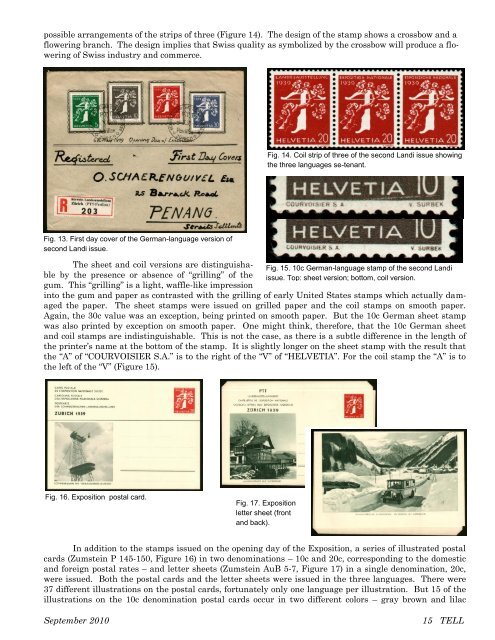Landi '39 - American Philatelic Society
Landi '39 - American Philatelic Society
Landi '39 - American Philatelic Society
Create successful ePaper yourself
Turn your PDF publications into a flip-book with our unique Google optimized e-Paper software.
possible arrangements of the strips of three (Figure 14). The design of the stamp shows a crossbow and a<br />
flowering branch. The design implies that Swiss quality as symbolized by the crossbow will produce a flowering<br />
of Swiss industry and commerce.<br />
Fig. 13. First day cover of the German-language version of<br />
second <strong>Landi</strong> issue.<br />
The sheet and coil versions are distinguishable<br />
by the presence or absence of “grilling” of the<br />
gum. This “grilling” is a light, waffle-like impression<br />
into the gum and paper as contrasted with the grilling of early United States stamps which actually damaged<br />
the paper. The sheet stamps were issued on grilled paper and the coil stamps on smooth paper.<br />
Again, the 30c value was an exception, being printed on smooth paper. But the 10c German sheet stamp<br />
was also printed by exception on smooth paper. One might think, therefore, that the 10c German sheet<br />
and coil stamps are indistinguishable. This is not the case, as there is a subtle difference in the length of<br />
the printer’s name at the bottom of the stamp. It is slightly longer on the sheet stamp with the result that<br />
the “A” of “COURVOISIER S.A.” is to the right of the “V” of “HELVETIA”. For the coil stamp the “A” is to<br />
the left of the “V” (Figure 15).<br />
Fig. 16. Exposition postal card.<br />
Fig. 14. Coil strip of three of the second <strong>Landi</strong> issue showing<br />
the three languages se-tenant.<br />
Fig. 15. 10c German-language stamp of the second <strong>Landi</strong><br />
issue. Top: sheet version; bottom, coil version.<br />
Fig. 17. Exposition<br />
letter sheet (front<br />
and back).<br />
In addition to the stamps issued on the opening day of the Exposition, a series of illustrated postal<br />
cards (Zumstein P 145-150, Figure 16) in two denominations – 10c and 20c, corresponding to the domestic<br />
and foreign postal rates – and letter sheets (Zumstein AuB 5-7, Figure 17) in a single denomination, 20c,<br />
were issued. Both the postal cards and the letter sheets were issued in the three languages. There were<br />
37 different illustrations on the postal cards, fortunately only one language per illustration. But 15 of the<br />
illustrations on the 10c denomination postal cards occur in two different colors – gray brown and lilac<br />
September 2010 15 TELL

















